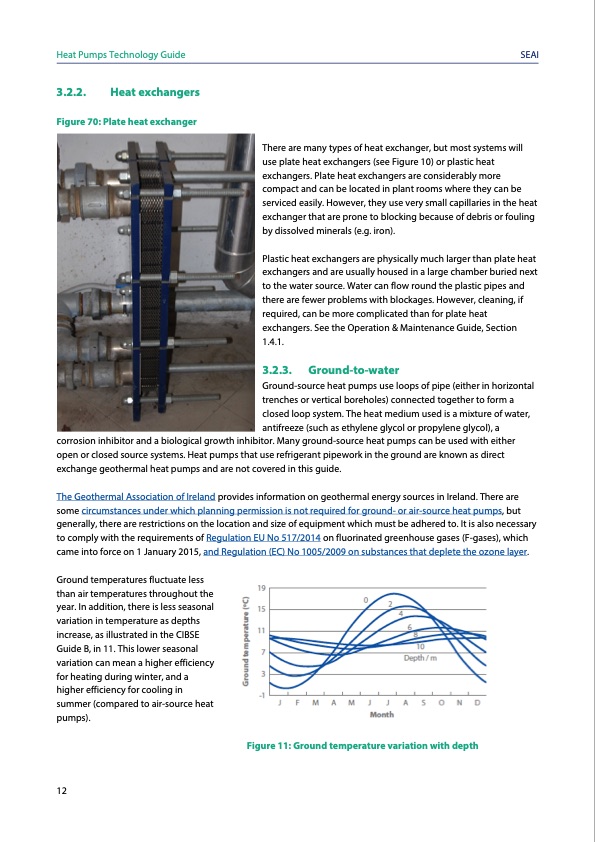
PDF Publication Title:
Text from PDF Page: 016
Heat Pumps Technology Guide SEAI 3.2.2. Heat exchangers Figure 70: Plate heat exchanger There are many types of heat exchanger, but most systems will use plate heat exchangers (see Figure 10) or plastic heat exchangers. Plate heat exchangers are considerably more compact and can be located in plant rooms where they can be serviced easily. However, they use very small capillaries in the heat exchanger that are prone to blocking because of debris or fouling by dissolved minerals (e.g. iron). Plastic heat exchangers are physically much larger than plate heat exchangers and are usually housed in a large chamber buried next to the water source. Water can flow round the plastic pipes and there are fewer problems with blockages. However, cleaning, if required, can be more complicated than for plate heat exchangers. See the Operation & Maintenance Guide, Section 1.4.1. 3.2.3. Ground-to-water Ground-source heat pumps use loops of pipe (either in horizontal trenches or vertical boreholes) connected together to form a closed loop system. The heat medium used is a mixture of water, antifreeze (such as ethylene glycol or propylene glycol), a corrosion inhibitor and a biological growth inhibitor. Many ground-source heat pumps can be used with either open or closed source systems. Heat pumps that use refrigerant pipework in the ground are known as direct exchange geothermal heat pumps and are not covered in this guide. The Geothermal Association of Ireland provides information on geothermal energy sources in Ireland. There are some circumstances under which planning permission is not required for ground- or air-source heat pumps, but generally, there are restrictions on the location and size of equipment which must be adhered to. It is also necessary to comply with the requirements of Regulation EU No 517/2014 on fluorinated greenhouse gases (F-gases), which came into force on 1 January 2015, and Regulation (EC) No 1005/2009 on substances that deplete the ozone layer. Ground temperatures fluctuate less than air temperatures throughout the year. In addition, there is less seasonal variation in temperature as depths increase, as illustrated in the CIBSE Guide B, in 11. This lower seasonal variation can mean a higher efficiency for heating during winter, and a higher efficiency for cooling in summer (compared to air-source heat pumps). 12 Figure 11: Ground temperature variation with depthPDF Image | Heat Pumps Technology Guide

PDF Search Title:
Heat Pumps Technology GuideOriginal File Name Searched:
Heat-Pump-Technology-Guide.pdfDIY PDF Search: Google It | Yahoo | Bing
CO2 Organic Rankine Cycle Experimenter Platform The supercritical CO2 phase change system is both a heat pump and organic rankine cycle which can be used for those purposes and as a supercritical extractor for advanced subcritical and supercritical extraction technology. Uses include producing nanoparticles, precious metal CO2 extraction, lithium battery recycling, and other applications... More Info
Heat Pumps CO2 ORC Heat Pump System Platform More Info
| CONTACT TEL: 608-238-6001 Email: greg@infinityturbine.com | RSS | AMP |